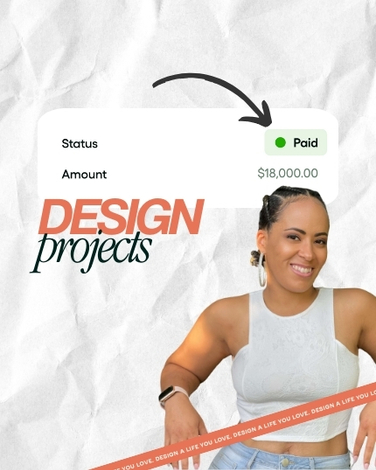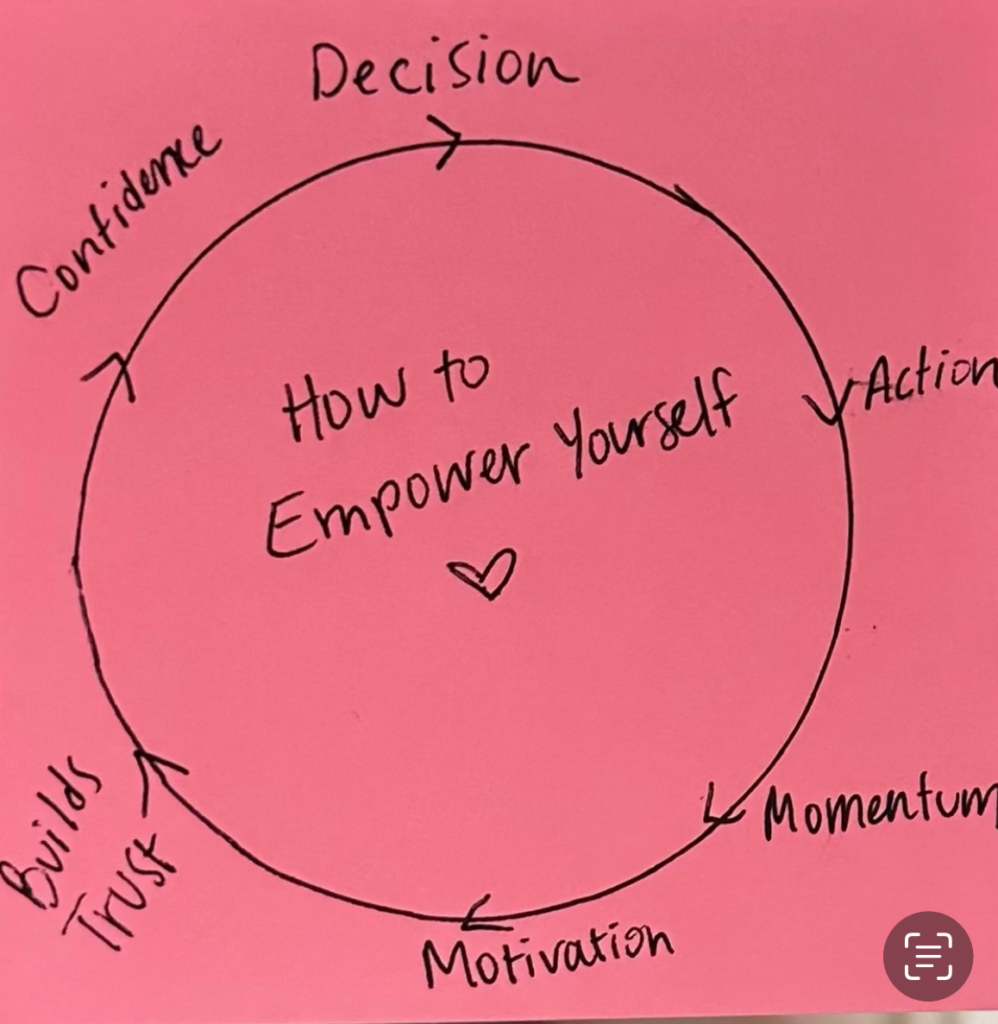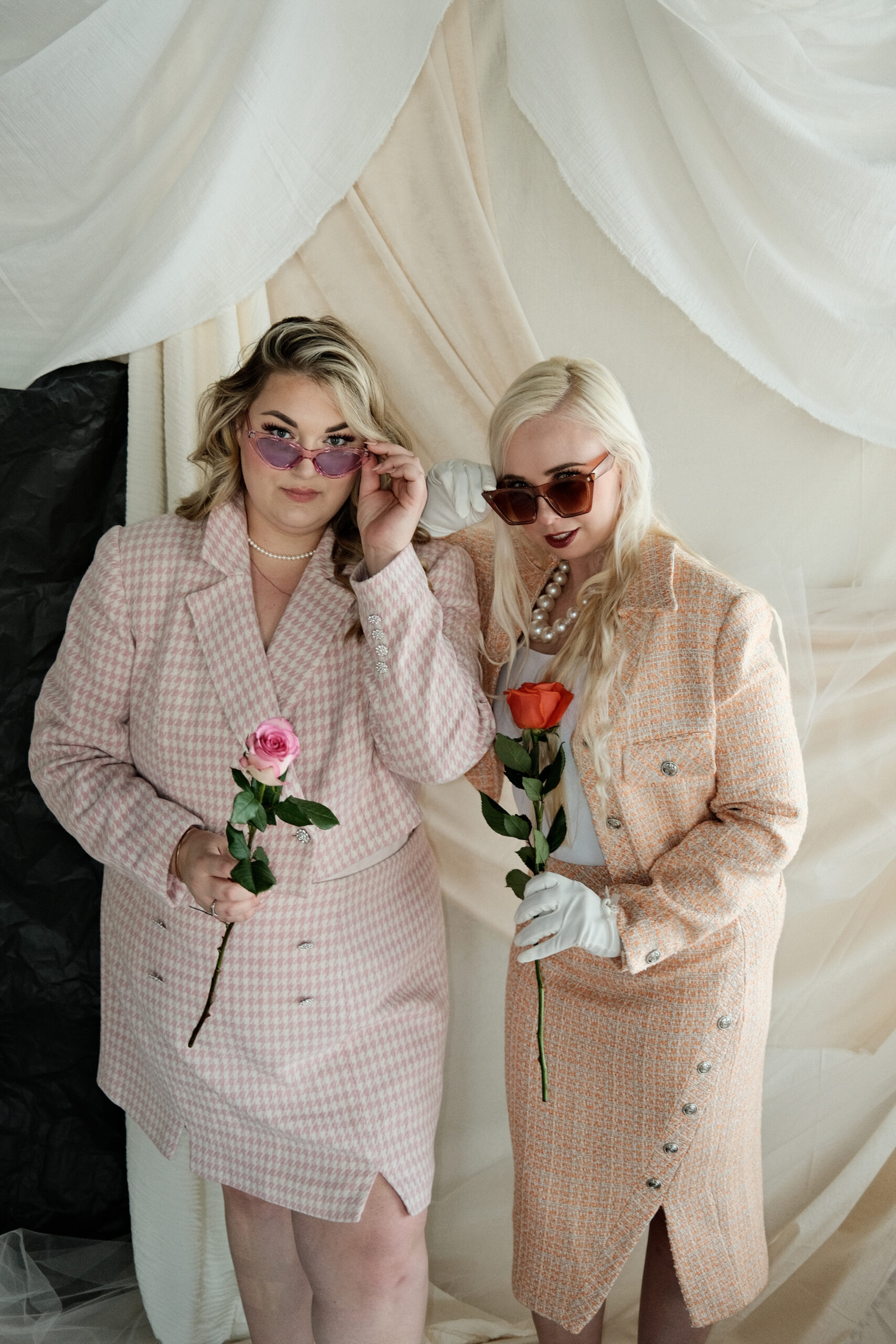Search The Directory
Blogging
Brand Design
Calligraphy
Coaching
Consulting
Copywriter
Film
Illustration
Interior Design
Lettering
Marketing
Motion Graphics
Packaging
Painting
Pattern Design
Photo Editing
Photography
Podcasts
Product Design
Shop Owner
Social Media
Textile Design
Type Design
Video
Web Design
Web Development
Writing
All
UI/UX
Styling
Virtual Assistant

Our recent DBA University graduate, Asia has booked $18K worth of brand & website design projects after enrolling in Design Biz Academy University at The Brief Collective. Here are some of the reasons she was able to achieve this so quickly. 1. Basic Business Foundation – Asia had already worked with a few clients and […]
Our recent DBA University graduate, Asia has booked $18K worth of brand & website design projects after enrolling in Design Biz Academy University at The Brief Collective. Here are some of the reasons she was able to achieve this so quickly.
1. Basic Business Foundation – Asia had already worked with a few clients and created her own website before joining Design Biz Academy University. This gave her a head start and she already taken the leap to full time self employment even though it was scary!
2. “just do it attitude” – When Coach Marisa first told her to charge a minimum of $8,000 on her upcoming project, she thought no one was going to pay that price! She nearly second-guessed charging that amount, fearing the client would walk away, but she stood her ground just in time. The “just do it” attitude landed her an $8K design project before even graduating our program.
3. Stopped Discounting – Before joining our program, Asia quoted a client $5K and they initially said it was “too expensive” but she didn’t discount her prices to fit their budget. This same client came back and booked at her desired price point a few weeks later during our program.
4. Invested In Herself – She told us that 2024 started off slow, and as imposter syndrome began to creep in, she felt stuck. But she knew the only way was up, so she invested in DBA, believing it was the key to turning her business around.
5. Committed fully to the DBA process – Asia did every assignment, showed up to every call, and committed to our program without question. She put in the work and continues to put in the work even after graduating.
These are the type of results our students can get from our DBA University program. Since joining DBA Asia has booked two $5K clients and an $8K client resulting in a total return on investment of $18K.
That is more than 5x her original DBA investment. Remember, it takes a single high ticket client to make your investment back.
Many designers spend years trying to figure it all out on their own, but with DBA, you get a step-by-step plan handed to you, guiding you straight to your first high-ticket client within months. If you’re ready to get results like this in your design business, consider joining DBA University. And if you’re ready but need that final reassurance, you can schedule a 1:1 consultation with us by clicking here.

Have you been empowering yourself? As creatives, we need to empower yourself. Our ability to connect with our hearts is essential for producing truly impactful designs. Creativity is deeply rooted in the heart’s work, while design thrives on the synergy of strategy and creativity. This requires us to be in tune with both our hearts […]
Have you been empowering yourself?
As creatives, we need to empower yourself. Our ability to connect with our hearts is essential for producing truly impactful designs. Creativity is deeply rooted in the heart’s work, while design thrives on the synergy of strategy and creativity. This requires us to be in tune with both our hearts and minds.
That’s why us creatives have such a hard time fitting into the professional world. It wasn’t designed for us. That’s why we’re on a mission to change the Design Industry from the inside out.
Let’s talk about the empowerment circle.
The empowerment circle is a cycle that we all should be familiar with. Something that could change the way you run your business or even live your life

Making a decision and taking action
The empowerment circle starts with making a decision. This is where a lot of people trip up. Don’t overthink things. Make that decision and start taking action. Remember, anything that you’re thinking of doing in your business is no-good if it sits in your brain doing nothing. It’s time to take action
Motivation comes from momentum
Once you start making decisions and taking action it begins to build momentum. You get into this flow of working, something that creates motivation. You know how great it feels to get into the flow of working and how it feels like you could work forever. This is what causes motivation. Make the decision, take action and allow it to build momentum and that motivation will come
It’s time to start building trust
Here’s the best part about the empowerment circle. Once this momentum builds up and this motivation kicks in, you often forget about your worries. You start to build trust in yourself, even if its subconsciously. This trust is something that is crucial to empowering yourself. And what does this bring? Confidence. You start to trust yourself more, feel more confident in what you do and eventually it empowers you.
To empower yourself is a cycle
This isn’t a circle by coincidence. Once you start feeling that trust in yourself again, you start trusting your ability to make a decision and take action. The confidence boost you get from going through this cycle allows you to make the next decision and take action with less worries, starting the circle again. The more you continue this cycle, the more you start empowering yourself.
Empowering yourself is the key to success
It all begins with us, to empower ourselves to embrace our unique perspective. While our minds may lead us along familiar paths, it’s when we allow our hearts to lead us that we discover new possibilities, gain confidence, and trust ourselves.
It is often more scary and more unknown to do this but it’s worth it if you can find your flow. It’s time to empower ourselves.
We cover many topics related to mindset, confidence and empowerment in DBA University, a 3 month program for brand designers looking to book high ticket clients and boost their design business

In the design industry, TBC sees a lot of designers struggle with talking about money and setting the right prices. Overcoming these challenges is so important not only for personal success but also for the industry as a whole.
In the design industry, TBC sees a lot of designers struggle with talking about money and setting the right prices. Overcoming these challenges is so important not only for personal success but also for the industry as a whole. And it all comes down to one thing. Mindset. Here’s a simple guide for you to work on your mindset to help you raise your prices.
Recognize Your Value:
It’s crucial to recognise your own skills and creativity. This is something we encourage our students to do in DBA University. Knowing what you bring to the table is the first step in setting fair prices. Your work is probably more valuable than you think.
Switch Your Thinking:
Instead of worrying about losing clients, focus on the many opportunities that come with charging based on the value you provide. This is quite simply, value based pricing. Raising your prices doesn’t limit your opportunities for clients, it just sets you up to avoid the red flag clients a little more. Coach Kenzi was recently a guest on Guidance Councelor Robin’s podcast about this topic. If you want to learn more about the difference between high ticket clients and low ticket clients, listen to the episode here. Setting higher prices sets a positive standard for the entire industry.
Talk About Money Clearly:
The reason you’re scared of money could be because you’re not talking about it. We’re taught that money is a taboo topic and shouldn’t be discussed unless it’s behind closed doors. Don’t be afraid to discuss your rates openly. Clearly explain the value you provide, and be transparent. This helps build trust with your clients and even potential clients, while making pricing discussions less uncomfortable for others too.
Know the Industry Standards:
Since not a lot of designers are discussing their rates, it’s difficult to conduct research to find what others in the industry charge. That’s why we created our TBC pricing guide for designers who are stuck on where to begin.
Showcase Your Work:
Probably a really crucial one for your mindset that probably gets overlooked. Building a strong portfolio that highlights your best projects not only attracts higher-paying clients but also gives you confidence in raising your prices.
Educate Your Clients:
Low prices are an issue across the entire design industry. You can’t expect clients to know everything about it. Help clients understand the value of your work. This can be done with attraction marketing which is something we teach all of our students in DBA University.
Raising your prices isn’t just about making more money for yourself;
It’s about making the design industry stronger as a whole.
By working on your mindset and pricing strategies, you can help us build a more sustainable and respected creative community and break the starving artist mentality.
Embrace your value, talk about money openly, and set a standard that reflects the quality of your work.

Brand and web design go hand in hand. A cohesive brand identity can boost the effectiveness of web design, creating a seamless online experience. This post explores the untapped potential of integrating web design into your services to boost your business revenue Building Your Skill Set Expanding your skill set to offer both brand and […]
Brand and web design go hand in hand. A cohesive brand identity can boost the effectiveness of web design, creating a seamless online experience. This post explores the untapped potential of integrating web design into your services to boost your business revenue
Building Your Skill Set
Expanding your skill set to offer both brand and web design elements can bring client opportunities from those who need a full brand makeover.
It’s important not to overwhelm your clients with a huge range of different services on your website. You want it look less like a menu and more like a professional elevated service offering. By integrating with design into your existing branding services, you can offer more value & allow you to raise your prices without adding an extra service to your existing offerings.
Meeting Demand
A lot of brand and web designers (including Coach Kenzi) don’t like working on websites that they haven’t built the brand identity for.
It can be harder to communicate the needs, especially if the web designer need something from the brand designer and vice versa.
By offering website design bundled with your existing brand design services, your meeting a demand for websites so you’re branding client doesn’t have to hire an external web designer.
This not only brings more revenue to your business as you are offering more, but it can bring higher client satisfaction. If a client needs any tweaks or changes to their brand or their website, they can come straight to you opening up more revenue opportunities later down the line for your business. Higher client satisfaction = more referrals/word-of-mouth marketing — which is extremely powerful
But what if I don’t want to offer web design?
If you are not ready to offer web design, or you feel it’s not something you’re interested in doing for a client, learning web design can still be beneficial for your business and bring more revenue in the long run.
Our Semester 5 DBA University Graduate & Guidance Counsellor Robin is open to learning website design but does not want to offer it in her services yet.
Robin will still be taking our DBA Tech Institute — a new web design course to learn how to build strategic websites. If you’re like Robin, and you feel like you don’t want to offer web design, having the knowledge of strategic website building can I help you build your website. Even if you’re not doing it for clients, you still have your own website that needs to be strategic and focus on the clients journey in order to attract more clients and ultimately make more money.
And it’s never a bad thing to have extra skills under your belt.
The world of design is filled with opportunities. You just have to be open to taking them on.
The key to earning more in your business is not always offering brand-new shiny services, sometimes it’s about integrating a new skill into the offerings that you already have.
That’s why we have built DBA Tech Institute. This is an interactive course for those who are looking to build strategic websites and it starts in January 2024. We are currently in rolling for our first ever semester, and we can’t wait to see some new faces as well as some of our previous DBA University students.
If you’re ready to boost your business revenue by offering strategic web design, click here to learn more about DBA Tech Institute

In this post, we’re going to cover some of the less known ways to attract dream clients and take your design business to the next level.
In the world of design, finding ways to attract dream clients and connect with them makes a huge difference. In this post, we’re going to cover some of the less known ways to attract dream clients and take your design business to the next level.
Podcast Presence
Podcasts are a great place to discuss your expertise in long form. It’s worth applying to be a guest on a podcast that aligns with your niche. Share your insights, show your knowledge and expertise, and offer valuable tips to position yourself as a professional. Remember, it’s all about applying for the podcasts that your dream clients are listening to!
SEO Strategies
While most designers focus on optimizing websites for search engines, consider incorporating your designer credit into the web footers of the sites you design. This is a small and subtle approach that can serve as a passive marketing tool, attracting those interested in the creative mind behind the designs they see on the websites they’re visiting.
Share Success Stories on Social Media
Brag about yourself a little bit! Tap into the power of social media by celebrating your business wins on socials. Share your success stories, share client testimonials, and highlight some of your work to create a positive image of your brand. Consider using authentic storytelling to humanize your brand and build trust and connection with potential clients.
Networking
Networking sounds like this big, serious word, but it can make a significant difference in your business. Consider attending industry events that are happening both in your local area and online. You could also consider organizing your own more intimate gatherings in the form of design-themed dinners, workshops, or virtual coffee meetups. Allow yourself to form genuine connections with others.
Embrace your own confidence
Confidence is key in the creative industry overall. It’s time to show your unique design style and express your passion for your work. Confidence not only attracts clients but builds trust and makes them feel more confident in you too. Remember, clients are drawn to designers who believe in their craft and can communicate its value effectively.
Conclusion:
The design industry is constantly changing, and thinking outside the box is what’s going to make you stand out. By exploring these opportunities and not being afraid to embrace your own confidence, you can create a distinct niche that forces you to stand out in such a huge industry.
If you’re ready to learn more about how to attract dream clients, consider Client Camp, our 2 hour workshop to learn all about attracting clients for only $27. Read more here
In client camp, we are sharing some of our top techniques for consistently attracting high ticket clients & breaking down our high ticket formula.

Let’s talk about niching down. We know as a designer you may be struggling with niching down. This could be for a number of reasons. Let’s dive in.
Let’s talk about niching down. We know as a designer you may be struggling with niching down. This could be for a number of reasons including:
You don’t want to cut off potential client work.
You don’t want to stick with only one industry
You’re worried you’ll change your mind later down the line
A lot of these problems aren’t actually issues surrounding Niching down. Developing more of a understanding of what a niche is and what niching down can do for your business is could put your business at an advantage, not a disadvantage.
What is Niching?
Niching down isn’t about forcing your business into a box that it can’t escape from. Instead, its your chance to open your design business up to more opportunities. Having a niche forces your business to stand out and showcases your unique skills and approaches. Remember, if you’re for everyone, you’re for no-one.
You don’t have to niche down by a specific industry or even design style. You can niche down by the solutions you provide, the skills you have, your unique approach to branding, your unique client experience… the list goes on
A lot of designers say finding your unique design style is crucial and for a lot of designers, especially those who are just starting out, this can feel overwhelming. If you haven’t quite figured out what your design style is yet, or if you like working with a range of different styles, this post is for you.
Why Niche Down?
Niching down is supposed to help you. In our Design Biz Academy University, we see a lot of students come in with a lack of direction on their niche. And that’s okay! However, by the time they have completed DBA, they are more clear on their specific target audience, their strengths and their confidence for owning these strengths.
Finding your niche can look different for everyone, but it’s an important thing to consider when working on your business.
Think about it this way:
If you decided you wanted facial plastic surgery, and you had the choice between the Plastic Surgeon or the General Surgeon, who would you choose to do your surgery?
It’s the plastic surgeon, right?
What if the plastic surgeon charged more. What if the general surgeon has performed plastic surgery before and is confident in this surgery? The majority of people would still choose the plastic surgeon.
Why? Because the plastic surgeon has dedicated their career to this specialty.
People are willing to pay premium prices to have their specific problem solved. If you can identify the one thing that you’re really good at, own that thing. Practice those skills, do more research and learn more about it. Because when a potential client comes looking for a designer who can solve their specific problem, they’re looking for a designer with a specialty, not a Jack of all trades.
An example:
DBA University Semester 5 Graduate Robin decided to niche down and get more clear on her target audience. She used to receive over 100 inquiries a month. However, she shared that these inquiries were people looking for one time logo designs, merch designs or just smaller projects that didn’t align with her skills. Only a couple inquiries out of the 100 were brand identity projects.
She soon realised why this happened. It was because she didn’t open talk about how she only provided full brand identity design projects in her marketing.
Once she became more clear on her ideal audience and figuring out what she specialised in, she began making content for those people and those people only.
Now she receives less than 20 inquiries a month, sometimes even less than 10. Again, sounds like a limitation, right?
However, the majority of these projects are full brand identity design project inquiries, which in the end, leaves her with more opportunities for work.
More inquiries does not always mean more work.
But what if I change my mind?
You’re allowed to. That’s okay.
Imagine this: 6 months after niching down, and you get a inquiry that’s a little outside your ideal project, but you’re excited to do something different. The client who is inquiring may be 100% okay with investing in your services, because they can see what you’ve done in your niche already.
You can always expand your niche.
This is your business and your journey, so don’t listen to advice from anyone who isn’t where you want to be.
You get to decide who you take and who you don’t. But again, if you’re for everyone, you’re for no one.
We cover Niching down in DBA University by helping our students identify their ideal client and tailoring their business to speak to those people only. You can find more about DBA University here!

At The Brief Collective we believe the design industry should have a code of ethics. Ethics are simply moral principles that govern a persons behaviour or conducting activity. Being a designer isn’t just about the design itself, its about identifying problems and giving effective solutions to your client or yourself. We’ve all heard of the […]
At The Brief Collective we believe the design industry should have a code of ethics. Ethics are simply moral principles that govern a persons behaviour or conducting activity.
Being a designer isn’t just about the design itself, its about identifying problems and giving effective solutions to your client or yourself.
We’ve all heard of the code of ethics in health care, right?
Autonomy — Honouring the patients right to make their own decisions.
Beneficence — Helping the patient advance for their own good.
Nonmaleficence — To do no harm.
Justice — To be fair and treat like cases alike.
Although design isn’t the same as saving lives, the two have more similarities than you might think.
Design has power.
Considering how you are able to help people when designing is crucial, as well as acknowledging ways you could hurt someone through design. You are responsible for the creations you put into the world. It has your name on it and ignorantly producing work that harms others, even accidentally, makes you responsible.
Thou shall not copy ideas of any kind
There are two types of copying; moral and immoral. If you copy something that sparks inspiration, make it your own and credit the original creator, this can be considered moral. Ensuring the work has your own spin on it is the main thing that separates moral from immoral.
At the other side, blatantly copying someone’s work and trying to pass it off as your own, disregarding the hard work of the original creator becomes immoral copying, also known as plagiarism.
Accidental copying happens sometimes and knowing how to spot it is crucial, missing it can harm your reputation as a designer, whether it was intentional or not.
A designer seeks to build the community, not divide it.
At TBC we’re big believers in ‘Community over Competition’. When you become a designer, you join a community. When designing for a client it isn’t always just you and them. It’s crucial to think about how your work impacts others. If you’re dishonest with a client or on a project, another designer may have to fix it. If you hand out discounts when they aren’t needed, the design industry becomes devalued.
You are responsible for your own professionalism in business, but all designers in the community are responsible for maintaining a standard that we all deserve to work at including being paid fairly.
A designer always seeks out what they do not know and always improves
Not knowing something doesn’t have to be shameful. We know imposter syndrome can get the best of you, but we often don’t realise the potential of our own brains and skills.
Get comfortable with seeking out things you don’t know and take time to learn about them.
Aim to make your next design better than the last. Do passion projects and test out new tools, techniques and ideas.
And most importantly, listen to other people’s experiences and be open to diversity within people and design. Diversity leads to stronger outcomes and better designs.
Fear the consequences of design more than the cleverness of our ideas.
The main point of design is that it’s there to solve a problem. It’s our role as designers to ensure the impact our work makes on society is a positive one. We must judge the value of our work through the impact it makes rather than aesthetics alone. An aesthetically pleasing design doesn’t always mean a successful design.
Honor your expertise
Appropriate feedback shouldn’t be looked at in a negative light. Change your point of view. Instead, look at it as advice for improvement that makes your good work even better.
Encourage your clients to give you feedback often throughout the process as this increases the chances of a successful project.
That being said, don’t be afraid to tell a client if you believe their suggestion is a bad choice. An aesthetically pleasing design doesn’t always mean a successful design. It’s our job as designers to provide the best possible solution we can while honouring the clients wishes, but this doesn’t mean you should just do anything and everything they ask without questioning it.
Ask your client why they believe their choice is strategic, and use your expertise as a designer to evaluate if this will work for the client. If not, it’s okay to speak up.
A code of ethics for the design industry is important because they guide us to tell the truth, remain accountable, solve problems and put out our best ideas.
In conclusion, allow this to be your reminder that design ethics are not just a theoretical concept but a practical framework that guides designers toward responsible and empathetic choices. Embrace design ethics and the design industry can continue to evolve in a direction that aligns with professionals and the community

Let’s talk about some key red flags that brand designers should keep an eye out for when looking to work with potential clients.
Navigating the world of brand design brings excitement but can also bring challenges. As designers, we’re passionate about crafting visual identities that resonate with our clients’ brands and make a lasting impact. However, not all clients are created equal, and it’s essential to be vigilant about potential red flags that could impact the design process and outcomes.
Let’s talk about some key red flags that brand designers should keep an eye out for when looking to work with potential clients. From incomplete inquiry forms to resistance against your process, each red flag holds important insights that can help you make decisions about the projects you take on. By recognizing red flags early, you can better navigate client relationships, maintain your creative integrity, and deliver your best work all while avoiding burnout.
Incomplete Inquiry Form
When a potential client fails to provide the information we ask for on the inquiry form, it’s more than just a minor oversight. Luckily, it’s one of the easiest red flags to spot and can be managed before you have even onboarded the client.
As designers we need to establish whether the potential client is a good fit for our skills and creative style. To make this decision, we need complete details and when clients don’t take the time to explain their requirements, it can lead to misunderstandings and designs that don’t meet their goals.
A lack of detail within the inquiry stage can also show a lack of passion for their business and a sign as to how this client would communicate throughout the project.
If this was to happen to you, you can reach out to the client for clarification. Politely request the missing information and emphasize its importance. Evaluate their responsiveness as it can provide insights into their level of commitment to the project.
Unclear Goals
Another onboarding stage red flag is when a potential client is unclear of their goals. It’s crucial to gather this information during an introduction call before the project begins.
As designers, we do our best work when the client has clear business goals. It ensures we can craft a brand identity that is directly connected to their brand strategy and business aims.
If the client is unclear on their goals, whether for the future vision of their brand, the visuals or design preferences — it can create problems.
Unclear directions often lead to extra design changes, burnout, and struggles in creating impactful branding.
Sometimes it’s difficult to know whether a client has no idea about their goals or whether they’re unsure on the way to articulate them. Start a conversation with the potential client to discuss their future vision, target audience, and design preferences. If the client remains uncertain it’s okay to offer guidance. It’s important to know that some potential clients simply are not ready for the investment yet — that’s okay too.
Resistance to your process
We have processes in place to make projects run as smoothly as possible. Having a consistent brand design process is like the secret sauce – it keeps things clear, maintains quality, brings everyone together, handles more work when needed, and maintains professionalism in your work.
When a potential client expresses objections to a designer’s set pricing structure, upfront payment expectations, or express doubts about the contract terms, these signs can indicate possible disagreements throughout the entire project.
If clients push back against a designer’s creative methods, it can disturb the natural flow of the design process. This resistance could be due to a lack of appreciation for the designer’s specialized skills or a tendency to test the limits of creative freedom.
Ultimately, this can put a strain on the relationship between the designer and the client. It places pressure on the designer leading to burnout and less desirable results. If one of these issues happens to be a refusal for placing a deposit, it can also lead to financial strain down the line.
If this red flag begins to arise, communicate to understand their worries. Talk to them in a respectful way, explaining why you do things the way you do. If they remain resistant, it’s okay to decline the project.
Requesting Discounts:
If a potential client consistently insists on reducing project costs, it could serve as a huge red flag.
Clients who heavily prioritize cost-cutting may not fully recognize the value of your professional design services. This can cause them to fail to take you and your work seriously.
Sticking to your established rates as a designer and resisting discounts is crucial to maintain the value of your expertise and communicate professionalism to clients.
It’s okay to approach discount requests with transparency. Explain how maintaining your rates ensures top-tier quality. If the client persists, be prepared to decline the project. If their budget cannot move and they are not ready for the investment, accepting a low ball offer could compromise your ability to deliver your best work. It can also de-value the entire design industry.
Disregard of boundaries
Clients who disregard a designer’s specified working hours, communication preferences, and project timelines can be a huge red flag. These issues can show a lack of respect for a designer’s professional boundaries, potentially leading to burnout, increased stress, and a compromised design process.
As designers we are best served by collaborating with clients who understand and respect our creative space and availability.
Remember to stick to your boundaries! When boundaries are questioned, be sure to reinforce them politely yet firmly. It’s okay to remind the client of the importance of mutual respect and effective communication for a successful project outcome. If the client continues to disregard your boundaries, don’t be afraid to politely decline the project.
Why is this important?
As brand designers, our ability to spot red flags is just as important as our design skills themselves. Incomplete forms, unclear goals, resistance to our processes, discount requests, and boundary issues offer a look into potential challenges ahead.
Being able to recognize and address these red flags early protects our creative integrity, maintains our professionalism, and builds productive relationships that result in your best design work.
Remember, as much as we’re passionate about design, it’s equally important to be passionate about the types of clients we work with. It’s all about the process and the experience, not just the design work itself.
We teach more about your boundaries in your business in Design Biz Academy University. Click here to learn more!

Being loyal to yourself is so important as an individual but also just as important as a professional in the design industry. It means embracing your authentic creative identity including your unique style, perspective, and values that define your work as well as taking care of yourself. This authenticity empowers you to create work that […]
Being loyal to yourself is so important as an individual but also just as important as a professional in the design industry. It means embracing your authentic creative identity including your unique style, perspective, and values that define your work as well as taking care of yourself.
This authenticity empowers you to create work that resonate deeply with both you and your audience, while building an emotional connection between your creations and your personal life.
Why is it important?
Being loyal to yourself is vital because it forms the foundation of a fulfilling life. When you prioritize your own values, goals, and identity, you create an alignment between your inner self and your actions. This can lead to an increase in self-esteem, a stronger sense of purpose, and improved overall well-being.
Remaining loyal to yourself also helps with decision-making, as choices made in line with your true self tend to be more thoughtful and meaningful. Within your professional work as a designer, it builds relationships, as authenticity attracts those who resonate with your real character.
Outside influences and distractions can tend to hinder your vision about yourself. Staying loyal to yourself acts as your personal compass that guides you toward a more balanced and fulfilling life.
Why is it relevant to my work?
Remaining true and loyal to yourself as a design professional holds significance as it allows you to stand out with a distinctive voice. It also allows for a smoother working process and work – life balance.
Loyalty fuels innovation, enabling you to feel comfortable through industry changes and challenges. Ultimately, staying true to yourself empowers your work and your career and can leave a huge positive impact on the design industry all while benefiting your personal life.
How can I practice it?
Practice Self-Care:
Prioritize your well-being to maintain your creative spirit. Nurture your creativity by seeking inspiration by trying hobbies outside of design. Take breaks when needed, rest when you feel you want to, and incorporate self-care practices into your daily life that rejuvenate your mind and fuel your creativity.
Be honest with yourself:
Take time to reflect on your values, goals, and aspirations. Consider what truly matters to you in various aspects of life, such as relationships, career, personal growth, and health. If there is anything you find that feels misaligned, face it upfront. Be honest with yourself as to where you need to improve to ensure you are taking care of yourself and set realistic goals that reflect your true desires.
Stay True to Your Values:
When it comes to working as a professional, it’s important to clarify your core values. When faced with choices in your work, consider whether they align with your personal values. Keeping up with your own principles not only brings authenticity to your work but also resonates with clients who share similar beliefs.
Set Clear Boundaries:
This should be done within your personal life and professional life. Establishing clear boundaries is essential for maintaining a healthy work-life balance and preserving your creative energy. Define your working hours, preferred methods of communication, and project scope from the outset in every single project you do. Clearly communicate these boundaries to clients to make sure there’s an understanding and a mutual respect as well as a focused working relationship that benefits both you and the client.
Celebrate Your Progress:
Acknowledge and celebrate your achievements along the way, no matter the size of them. Recognize successful parts of life and work as well as your personal growth as a designer. Celebrating even the small milestones helps to reinforce your commitment to your business and builds your confidence as you navigate your creative path.
Do what you think is right:
Challenge negative self-talk within yourself to get to the root of what you really think is the right thing to do. Even if this means risking disapproval from people in your life, or even turning down projects in your professional life. The key to a fulfilling life is navigating it with confidence. It’s important not to beat yourself down if you find you have made the wrong decision. Knowledge is power — be open to learning new things, especially those lessons that come from mistakes. Give yourself room to breathe.
And remember…
It’s important to remember that practicing self-loyalty is an constant journey that requires patience and effort. Just to be kind to yourself as you navigate through different situations. Be patient and focus on building a strong, compassionate relationship with yourself professionally and personally.

Setting professional boundaries is essential for your well-being, a productive work process and building successful relationships with clients all while setting clear expectations for the design industry as a whole.
Setting professional boundaries is essential for your well-being, a productive work process and building successful relationships with clients all while setting clear expectations for the design industry as a whole.
A lack of boundaries can not only lead to strain on your work but believe it or not — it can appear unprofessional. There are a number of different boundaries to set as a professional designer.
1. Discounting Rates
Throughout your design career, you may experience clients requesting discounts. It is essential to uphold the value of your services. Offering discounts can devalue your skills and expertise, suggesting that your regular rates may have been inflated in the first place. Sticking to your rates showcases professionalism and reinforces the value of your services.
Should a client ask for a discount, here is an example of a response:
“I understand that budget considerations are essential. Unfortunately, my rates are non-negotiable as they reflect the value of my work and my ability to deliver solutions.”
2. Appropriate Contact Methods
It’s important to outline the appropriate platforms that a client should contact you on. This looks different to every designer. Whether you choose contact through a work email or a dedicated channel such as Slack or a client portal, the appropriate contact methods should be outlined within your contract.
In the event of a client contacting you through a platform unauthorised for work [for example, social media], this should be addressed immediately.
An example of setting a boundary in a professional way is:
“I value open communication, however, it is important to prioritize a professional working relationship by focusing our agreed communication channels on project-related matters. This will help create a smooth workflow and timely project delivery”
3. Out of Hours Work
Alongside outlining the appropriate contact methods, outlining the appropriate times to contact you is just as important. Outlining your working hours sets clear expectations for when you are and are not available for work.
This particular boundary also allows you to prioritise a work-life balance ensuring you have time for personal commitments and rest outside of working hours.
Having your working hours clearly outlined in your project contract sets this boundary and expectation from the start.
However, in the event a client continues to contact you outside of your outlined working hours, here is an example of a response.
“I appreciate your enthusiasm about this project, however in order to give the provide my focused attention I have designated communication hours. Kindly reach out during [specified hours].”
4. Multiple Revisions
Sometimes designers receive the wonderful message of ‘signed off, no amends’. But sometimes, this isn’t always the case. It is crucial to outline the amount of revisions you would like to assign per project, as well as what will happen if this revision limit is exceeded.
Each designer and each project is unique, but outlining the revision limit allows you to set a fee for exceeded revisions to avoid back and forth amendments.
It is also encouraged to help your client give feedback. Ensuring their feedback is clear and detailed will avoid multiple small revisions and less back and forth amendments.
In the event of all provided revisions becoming exceeded and the client requests more smaller changes, here is an example of a professional response:
“Thank you for your feedback. As per our contract, the [number] of provided revisions has been exceeded. Let’s discuss your specific requirements in detail to address any extra revisions comprehensively and efficiently.”
What Happens When You Stick To Your Boundaries
Boundaries are the unsung hero of a successful design business. As designers, it is crucial to set boundaries to help you manage your time, be a true leader, stay loyal to yourself, and protect your inner peace which directly affects your creative energy. It helps the client view you as the trusted expert that you are. We often say to our students, “You are the captain of the boat. Not the client.”
Just as a ship needs a sturdy hull and a clear course to navigate treacherous waters, a designer needs boundaries to steer their business toward success. At The Brief Collective, we believe that setting and adhering to these boundaries is not just a choice — it’s a necessity for success.
Imagine sailing without a compass or a map. You’d be at the mercy of the waves, with no direction or purpose. Similarly, without boundaries, designers can find themselves adrift in a sea of client demands, endless revisions, and burnout. Boundaries are the compass and map that guides us, ensuring we stay on course and reach our desired destination.
- Time Management & Productivity: Time is a designer’s most precious resource. By setting clear boundaries, you ensure that every minute is spent purposefully. This not only boosts productivity but also ensures that you deliver quality work within the stipulated timeframe.
- Leadership & Authority: As the captain of your ship, you must lead with confidence. When you set boundaries, you’re asserting your expertise and value. Clients will respect and trust a designer who knows their worth and isn’t afraid to communicate it.
- Inner Peace & Creative Energy: The sea can be calm one moment and stormy the next. Similarly, the design world is filled with highs and lows. Boundaries act as a protective barrier, ensuring that external pressures don’t drain your creative energy. They allow you to maintain a sense of inner peace, which is crucial for creativity to flourish.
- Loyalty to Self: In the quest to please clients, it’s easy to lose sight of one’s own needs and values. Boundaries serve as a reminder to stay true to oneself. They ensure that while you’re committed to delivering exceptional work, you’re not compromising on your principles.
- Establishing Expertise: When you set boundaries, you’re not just protecting yourself—you’re also signaling to clients that you’re a seasoned professional. It’s a testament to your experience and expertise, making clients more inclined to view you as the trusted expert you truly are.
The Brief Collective’s Commitment
At The Brief Collective, we’ve seen firsthand the transformative power of boundaries. They’re the unsung heroes behind every successful design business. We’re committed to empowering designers with the tools and knowledge they need to set these boundaries confidently. Clear boundaries empower you as a designer by promoting productivity, managing expectations, and safeguarding your well-being, ultimately leading to more successful client projects and fulfillment in business.
We often say to our students, “You are the captain of your own boat.” And as every seasoned sailor knows, a ship is only as strong as its captain. So, set your boundaries, chart your course, and sail confidently into the horizon of success. Your business, your peace of mind, and your clients will thank you for it.
At The Brief Collective, we encourage all designers to protect themselves, their time and their inner peace.
Check out our Contract Template in our Designer Campus Store to ensure you, your business and your clients are protected.